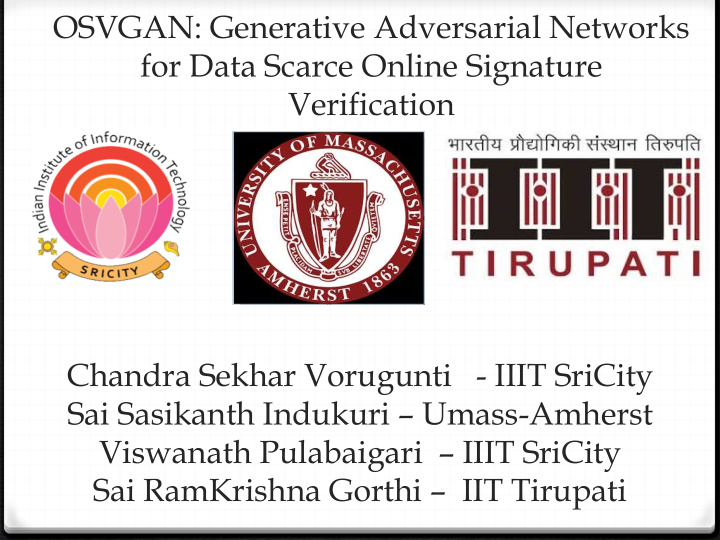



OSVGAN: Generative Adversarial Networks for Data Scarce Online Signature Verification Chandra Sekhar Vorugunti - IIIT SriCity Sai Sasikanth Indukuri – Umass-Amherst Viswanath Pulabaigari – IIIT SriCity Sai RamKrishna Gorthi – IIT Tirupati
Online and Offline Signature: Offline Signature : An image consists of Structural information (x, y coordinates). Contains : 1. Structural information (x, y coordinates). 2. Dynamic properties (such as velocity, pressure, acceleration, azimuth, total signature time etc.,) as numerical data captured through specialized devices.
Online Signature Verification(OSV): Challenges Challenge : 1. Very less number of signature samples per user. Maximum Genuine samples = 40 and Forgery samples = 25. 2. Impractical to acquire sufficient number of signature samples from users/writers. Consequence : 1. OSV frameworks are deployed into production systems by testing with limited samples per users. This results in lack of analysing load handling and robustness analysis of the system. 2. Lack of analyzing the performance metrics in case of more number of samples pers user. Solution : 1. Generating more number of signature samples using Generative Adversarial Networks and using these synthetic samples to critical evaluation of the frameworks.
Contributions : OSVGAN 1. As represented in Fig 1, a novel variant of Auxiliary Classifier-GAN (AC-GAN) based framework, which generates effective and unlimited writer specific synthetic signature samples. 2. As represented in Fig 2, we propose a Depth Wise Separable Convolution (DWS) based OSV framework, through which we achieve one shot learning with reduced parameters compared to standard convolution based neural networks.
Contributions : OSVGAN 1. As represented in Fig 1, a novel variant of Auxiliary Classifier-GAN (AC-GAN) based framework, which generates effective and unlimited writer specific synthetic signature samples. 2. As represented in Fig 2, we propose a Depth Wise Separable Convolution (DWS) based OSV framework, through which we achieve one shot learning with reduced parameters compared to standard convolution based neural networks.
OSVGAN: Synthetic Signature Generation. As depicted in Fig 1, 3 to generate high-quality writer specific synthetic signatures, we have proposed OSVGAN, which is a modified version of AC(Auxiliary Classifier)-GAN [5,28]. AC-GAN is widely used variant of vanilla GAN, in which, addition to the noise vector ′ 𝑜 ′, a corresponding label, 𝑚 ∼ 𝑄 𝑚 is given as an input to the generator G to generate writer specific synthetic signatures 𝑇 𝑡𝑧𝑜 = 𝐻 ( 𝑚 , 𝑜 ).
Online Signature Verification: AC-GAN
Online Signature Verification: AC-GAN Swaminathan et al [4] proposed a novel attempt in which, to increase the modelling power of the prior distribution, they have reparametrized [6] the latent generative space of vanilla GAN into a set of Gaussian mixture models and learn the best mixture model specific to each writer. Motivated by Swaminathan et al [4] work, we have reparametrized the latent generative space of Auxiliary Classifier GAN into a set of mixture models and learn the best mixture model specific to each writer.
Proposed OSV Framework: As depicted in Fig 2, a Gaussian random noise of size 5 is derived from the selected Gaussian distribution and the label embeddings are given as an input the Generator G. The generator generates the corresponding profile of an online signature of size 1*200. The signature profile is fed as an input to the discriminator ‘ 𝐸 ’, consists of a one- dimensional convolution layer, followed by three dense layers to classify the synthetic signature profile as real or generated. The generator is trained to generate the synthetic profiles close to the samples from the target space (signature dataset) through backpropagation of discriminator error in classifying the real and generated signature profiles.
GANOSV: Results : SVC Dataset
Proposed OSV framework: Contributions
OSVGAN: EER for each user
Conclusion In this work, two most challenging requirements of OSV are addressed. 1. Data scarcity to thoroughly test the framework for real time deployment in critical applications. --- To address this, we have proposed a first of its kind of an attempt to generate virtually unlimited synthetic signature samples per user from a maximum of 40 signatures per user based on a modified version of AC-GAN. 2. Achieving few shot learning, especially one-shot learning to classify the genuineness of test signature with as minimum as one training sample per user. The efficiency of the proposed model is confirmed through state-of-the-art achievement in various categories compared to the frameworks evaluated with reduced number of test samples. In future, to grasp the generative skills of GANs, we will focus on filling the missing and noisy parts of the signatures.
References 4. G.Swaminathan,S.R.Kiran and R.V.Babu, DeLiGAN : Generative Adversarial Networks for Diverse and Limited Data, 30TH IEEE conference on Computer viison and pattern recognition (CVPR 2017),pp. 4941-4949,JUL 21-26, 2017 5. A.Odena, C.Olah and J.B Shlens, Conditional image synthesis with auxiliary classifier GANs, 34th International Conference on Machine Learning (ICML), vol 70, pp:2642 – 2651, august 2017.
Thank You
Recommend
More recommend